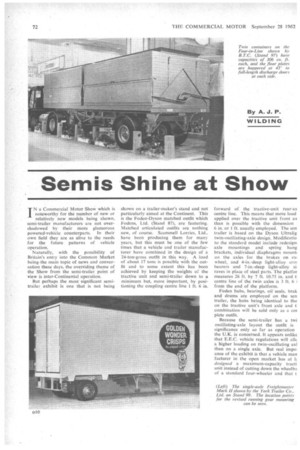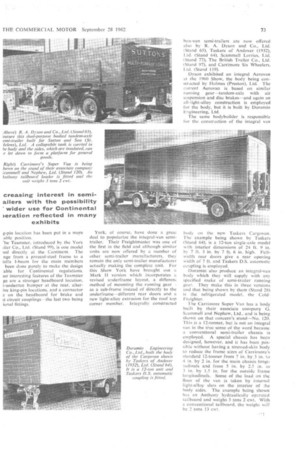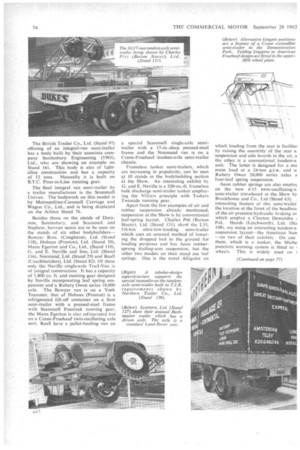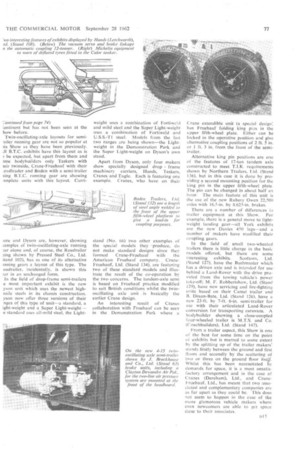Semis Shine at Show
Page 74

Page 75

Page 76

Page 79

If you've noticed an error in this article please click here to report it so we can fix it.
N a Commercial Motor Show which is noteworthy for the number of new or
relatively new models being shown, semi-trailer manufacturers are not overshadowed by their more glamorous powered-vehicle counterparts. In their own field they are as alive to the needs for the future patterns of vehicle operation.
Naturally, with the possibility of Britain's entry into the Common Market being-the main topic of news and conversation these days, the overriding theme of the Show from the semi-trailer point of view is inter-Continental operation.
But perhaps the most significant semitrailer exhibit is one that is not being shown on a trailer-maker's stand and not particularly aimed at the Continent. This is the Foden-Dyson matched outfit which Fodens, Ltd. (Stand 87), are featuring. Matched articulated outfits are nothing new, of course. Scammell Lorries, Ltd., have been producing them for many years, but this must be one of the' few times that a vehicle and trailer manufacturer have combined in the design of a 24-ton-gross outfit in this way. A load of about 17 tons is possible with the outfit and to some extent this has been achieved by keeping the weights of the tractive unit and semi-trailer down to a minimum but, more important, by positioning the coupling centre line 1 ft. 6 in.
forward of the tractive-unit rear-ax centre line. This means that more load applied over the tractive unit front ax than is possible with the dimension 6 in, or I ft. usually employed. The sen trailer is based on the Dyson Ultralig twin-oscillating-axle design. Modificatio to the standard model include redesign, axle mountings and spring hang brackets, individual, diaphragms mount on the axles for the brakes on ea, wheel, and 4-in.-deep light-alloy croE bearers and 7-in.-deep light-alloy si, raves in place of steel parts. The platfor measures 26 ft. by 7 ft. 10.75 in. and ti centre line of the twin axles is 3 ft. 6 i from the end of the platform.
Foden hubs, bearings, oil seals, brak and drums are employed' on the seri trailer, the hubs being identical to tho on the tractive unit's front axle and t combination will be sold only as a co-r piete outfit.
Because the semi-trailer has a twi oscillating-axle layout the outfit is significance only so far as operation the U.K. is concerned. It appears unlike that E.E.C. vehicle regulations will all( a higher loading on twin-oscillating axl than on a single axle. But real impo. ance of the exhibit is that a vehicle man facturer in the open market has at h designed a maximum-capacity tracti unit instead of cutting down the wheelba of a standard four-wheeler and that t
g-pirt location has been put in a more able position.
he Teamster, introduced by the York Wier Co., Ltd. (Stand 99), is one model ied directly at the Continent. The nge from a pressed-steel frame to a lella I-beam for the main members been done purely to make the design able for Continental regulations. ter interesting features of the Teamster ge are a stronger headboard location. i-underrun bumper at the rear, alterive king-pin locations, and a connector e on the headboard for brake and it circuit couplings—the last two being ion al fittings. York, of course, have done a great deal to popularize the integral-van 'semitrailer. Their Freightmaster was one of the first in the field and although similar units are now offered by a number of other semi-trailer manufacturers, they remain the only semi-trailer manufacturer actually making the complete unit. For this Show York have brought out a Mark II version which incorporates a revised underframe layout, a differeni method of mounting the running gear as a sub-frame instead of directly to the underframe—different rear doors and a new light-alloy extrusion for the roof top corner member. Integrally constructed
box-van semi-trailers are now offered also by R. A. Dyson and Co., Ltd. (Stand 65), Taskers of Andover (1932), Ltd. (Stand 64), Scamnnell Lorries, Ltd. (Stand 77); The British Trailer Co., Ltd. (Stand 97), and Carrimore Six Wheelers, Ltd. (Stand 119).
Dyson exhibited an integral Aerovan at the 1960 Show, the body being constructed by Holmes (Preston), Ltd. The current Aerovan is based on similar running gear---tandem-axlc with air suspension and disc brakes—and again an all-light-alloy construction is employed for the body, but it is built by Duramin Engineering, Ltd.
The same bodybuilder. is responsible or the construction of the integral van
body on the new Taskers Cargovan. The 'example being shown by Taskers (Stand 64), is a 12-ton single-axle model with interior dimensions of 24 ft. 9 in. by 7 ft. 3 in. by 1 ft. 6 in. high. Fullwidth rear doors give a rear opening width of 7 ft. and Taskers D.S. automatic coupling is employed.
Duramin also produce an integral-van body which they will supply with any specified make of semi-trailer running gear. They make this in three versions and that being shown by them (Stand 28) is the refrigerated model, the ColdFreighter.
The Carrirnore Super Van has a body built by their associate company G. Suarnmell and Nephew, Ltd., and is being shown on that concern's stand—No. 120. This is a 12:Tonner, but is not an integral van in the true sense of the word because a conventional semi-trailer chassis is employed. A special chassis has been designed, however, and it has been possible without having a stressed-skin body to reduce the frame sizes of Carri .1110Te'S standard 12-tonner from 7 in. by 3 in. to 4 in. by 2 in. for the main chassis Iongitudinals and from 5 in. by 2.5 in. 1.c, 3 in. by 1.5 in. for the outside frame longitudinals. Some of the load on the floor of the van is taken by internal light-alloy slats on the interior of the hotly sides. The example being shown has an Anthony -hydraulically operated tailboard and weighs 3 tons 2 cwt. With a conventional tailboard, the weight will be 2 tons 13 cwt.
The British Trailer Co., Ltd. (Stand 97) offering of an integral-van semi-trailer has a body built by their associate company Samlesbury Engineering (1961), Ltd., who are showing an example on Stand 141. This body is also of lightalloy construction and has a capacity of 12 tons. Naturally it is built on B.T.C. Four-in-Line running gear.
The final integral van semi-trailer by a trailer manufacturer is the Searnmen Univan. The bodywork on this model is by Metropolitan-Cammell Carriage and Wagon Co., Ltd., and is being displayed on the Albion Stand 76, Besides those on the stands of Duramin, Sainiesbury, and Scammell and Nephew, boxvan semis are to be seen on the stands of six other bodybuilders— Bowyer Bros. (Congleton), Ltd, (Stand 118), Holmes (Preston), Ltd. (Stand 50), Mann Egerton and Co., Ltd., (Stand 110), G. and E. Neville and Son, Ltd, (Stand 116), Normand, Ltd, (Stand 29) and Real! (Coachbuilders), Ltd. (Stand 82). Of these only the Neville single-axle Trail-Van is of integral construction. It has a capacity of 1,800 cu. ft. and running gear designed by Neville incorporating leaf spring suspension and a Rubery Owen series 18,000 axle. The Bowyer van is on a York Teamster, that of Holmes (Preston) is a refrigerated lift-off container on a Scot semi-trailer with a pressed-steel frame with Scammell Fourtrak running gear, the Mann Egerton is also refrigerated but on a Crane-Fruehauf twin-oscillating axle unit, Beall have a pallet-loading van on a special Scammell single-axle semitrailer with a 15-in.-deep pressed-steel frame and the Normand van is on a Crane-Fruehauf tandem-axle semi-trailer chassis.
Frameless tanker semi-trailers, which are increasing in popularity, can be seen at 10 stands in the bodybuilding section at the Show. An interesting exhibit by G. and E. Neville is a 520-cu.-ft. frameless hulk discharge semi-trailer tanker employing the Vill:ers principle with Taskers Twinside running gear.
Apart from the few examples of air and rubber suspension already mentioned, suspension at the Show is by conventional leaf-spring layout. Charles Pitt (Barton Stacey), Ltd. (Stand 131), shoat, the L35, 5/6-ton ultra-low-loading semi-trailer which uses an unusual method of lowering the dropped bed to the ground for loading purposes and has Aeon rubbersprung trailing-arm suspension, but the other two models on their stand use !eaf springs. One is the novel Alligator on
which loading from the rear is facilital by raising the assembly of the rear a: suspension and side boards in the air, a the other is a conventional tandem-a: unit. The latter is designed for a ma mum load at a 24-ton g.t.mi. and u: Rubery Owen 20,000 series axles a four-leaf spring suspension.
Aeon rubber springs are also employ on the new 4-15 twin-oscillating-a: semi-trailer introduced at the Show by Brockhouse and Co., Ltd (Stand 63). interesting feature of this semi-trailer the location at the front of the head boa of the air pressureihydraulic braking ur which employ a Clayton Dewandre Pak. Hands (Letchworth), Ltd. (Sta 108), are using an interesting tandem-a: suspension layout—the American Nem .—on two of their exhibits. On one them, which is a tanker, the Miche puncture warning system is fitted to 1 wheels. This is widely used on I
bntinent but has not been seen at the how before.
Twin-oscillating-axle layouts for semialter running gear are not so popular at is Show as they have been previously. .11 B.T.C. exhibits have this layout as is ) be expected, but apart from them and me bodybuilders only Taskers with teir twins ide, Crane-Fruehauf with their oadleader and Boden with a semi-trailer sing B.T.C. running gear are showing )mplete units with this layout. Carri 'ore and Dyson are, however, showing tamples of twin-oscillating-axle running :ar alone and, of course, the Roadrailer ing shown by Pressed Steel Co., Ltd. 4and 102), has as one of its alternative inning gears a layout of this type. The oadrailer, incidentally, is shown this :ar in an unchanged form.
In the field of drop-frame semi-trailers e most important exhibit is the new yson unit which uses the newest highnsile steels in its chassis construction. yson now offer three versions of their nges of this type of unit—a standard, a ight-weight and a Super Light-weight----e standard uses all-mild steel, the Light weight uses a combination of Fortiweld and mild steel and the Super Light-weight uses a combination of Fortiweld and (J.S.S.-TI steel. Models from the last two ranges are being shown—the Lightweight in the Demonstration Park and the Super Light-weight on Dyson's own stand.
Apart from Dyson, only four makers show specially designed drop frame machinery carriers, Hands, Taskers, Cranes and Eagle. Each is featuring one example. Cranes, who have on their
stand (No. 66) two other examples of the special models they -produce, do not make standard designs since they formed Crane-Fruehauf with the American Fruehauf company. CraneFruehauf, Ltd. (Stand 134), are featuring two of these standard models and illustrate the result of the co-operation by the two concerns. The tandem-axle semi is based on Fruehauf practice modified to suit British conditions whilst the twinoscillating axle unit is basically the earlier Crane design.
An interesting result of Cranes collaboration with Fruehauf can be seen in the Demonstration Park where a Crane extendible unit (a special design; has Fruehauf folding king pins in the upper fifth-wheel plate. Either can be locked in the operative position and give alternative coupling positions of 2 ft. 5 in. or I ft. 3 in. from the front of the semitrailer.
Alternative king pin positions are one of the features of 17-ton tandem axle constructed to meet T.I.R. requirements shown by Northern Trailers, Ltd. (Stand 136), but in this case it is done by providing a second mounting position for the king pin in the upper fifth-wheel plate. The pin can be changed iii about half an hour. The main feature of this unit is the use of the new Rubery Owen 22,500 axles with 16.5-in. by 8,625-in. brakes.
'there are a number of differences in trailer equipment at this Show. For. example, there is a general move to lightweight landing gear—all York exhibits use the new Davies 450 legs—and a number of makers have modified their coupling gears.
In the field of small two-wheeled trailers there is little change in the basic models offered, but there are some interesting exhibits. Scottorn, Ltd. (Stand 127), have the Bushmaster which has a driven axle and is intended for use behind a Land-Rover with the drive provided from the towing vehicle's power take-off; M. F. Robbertshaw, Ltd. (Stand 129), have new servicing and fire-fighting units based on their Camel trailer and 13. Dixon-Bate, Ltd. (Stand 126), have a new 23-ft. by 7-ft. 6-in, semi-trailer for use with their articulated Land-Rover conversion for transporting caravans. A bodybuilder showing a close-coupled four-wheeled trailer is M.T.S. and Co. (Coachbuilders), Ltd. (Stand 147).
From a trailer aspect, this Show is one of the best for some time on the point of exhibits but is marred to some extent by the splitting up of the trailer makers' stands firstly between the ground and first floors and secondly by the scattering of two or three on the ground floor itself. Whilst this has been necessitated by demands for space, it is a most unsatisfactory arrangement and in the case of Cranes (Dereham), Ltd., and CraneFruehauf, Ltd., has meant that two associated and complementary companies are as far apart as they could be. This does not seem to happen in the case of the more glamorous vehicle makers where even newcomers are able to get space close to their associates.






































































































































































